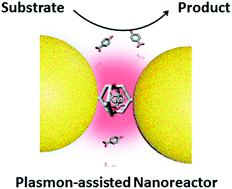当前位置:
X-MOL 学术
›
Chem. Sci.
›
论文详情
Our official English website, www.x-mol.net, welcomes your feedback! (Note: you will need to create a separate account there.)
Molecular cage-bridged plasmonic structures with well-defined nanogaps as well as the capability of reversible and selective guest trapping†
Chemical Science ( IF 7.6 ) Pub Date : 2017-11-20 00:00:00 , DOI: 10.1039/c7sc03536e Chen Wang 1 , Li Tian 1 , Wei Zhu 2 , Shiqiang Wang 1 , Ning Gao 1 , Kang Zhou 1 , Xianpeng Yin 1 , Wanlin Zhang 1 , Liang Zhao 1 , Guangtao Li 1
Chemical Science ( IF 7.6 ) Pub Date : 2017-11-20 00:00:00 , DOI: 10.1039/c7sc03536e Chen Wang 1 , Li Tian 1 , Wei Zhu 2 , Shiqiang Wang 1 , Ning Gao 1 , Kang Zhou 1 , Xianpeng Yin 1 , Wanlin Zhang 1 , Liang Zhao 1 , Guangtao Li 1
Affiliation

|
Creating well-defined plasmonic hotspots with enormous field enhancements as well as the capability of selectively trapping targeted molecules into hotspots is of critical importance and a prerequisite for numerous plasmon-assisted applications, but it represents a great challenge. In this work, a robust molecular cage decorated with thioether moieties at the periphery was designed and synthesized. By using the synthesized cage as a linker, a series of molecular cage-bridged plasmonic structures with well-defined nanogaps (hotspots) were fabricated in an efficient and controllable fashion. It was found both experimentally and theoretically that the nanogaps of about 1.2 nm created by the molecular cage in the resultant plasmonic structures led to a strong plasmon coupling, thus inducing great field enhancement inside the nanogaps. More importantly, the embedded molecular cages endowed the formed hotspots with the capability of selectively trapping targeted molecules, offering huge opportunities for many emergent applications. As a demonstration, the hotspots constructed were used as a unique nanoreactor, and under mild conditions two types of plasmon-driven chemical transformation were successfully performed. All the results clearly indicate that the integration of the host–guest chemistry of the molecular cage with the plasmon-coupling effect of metal particles afforded a new class of plasmonic structures, showing great potential for facilitating a broad variety of plasmon-based applications.
中文翻译:

具有明确纳米间隙以及可逆和选择性客体捕获能力的分子笼桥等离子体激元结构†
创建具有巨大场增强的定义明确的等离子体热点以及选择性地将目标分子捕获到热点中的能力是至关重要的,也是许多等离子体辅助应用的先决条件,但它代表了一个巨大的挑战。在这项工作中,设计并合成了一个在外围装饰有硫醚部分的坚固分子笼。通过使用合成的笼作为连接器,一系列具有明确纳米间隙(热点)的分子笼桥等离子体结构以有效和可控的方式制造。实验和理论上都发现,由分子笼在所得等离子体结构中产生的约 1.2 nm 的纳米间隙导致强等离子体耦合,从而在纳米间隙内引起很大的场增强。更重要的是,嵌入的分子笼使形成的热点具有选择性捕获目标分子的能力,为许多新兴应用提供了巨大的机会。作为示范,将构建的热点用作独特的纳米反应器,并在温和条件下成功进行了两种等离子体驱动的化学转化。所有结果清楚地表明,分子笼的主客体化学与金属粒子的等离子体耦合效应的整合提供了一类新的等离子体结构,显示出促进各种基于等离子体的应用的巨大潜力。构建的热点用作独特的纳米反应器,在温和条件下成功进行了两种等离子体驱动的化学转化。所有结果清楚地表明,分子笼的主客体化学与金属粒子的等离子体耦合效应的整合提供了一类新的等离子体结构,显示出促进各种基于等离子体的应用的巨大潜力。构建的热点用作独特的纳米反应器,在温和条件下成功进行了两种等离子体驱动的化学转化。所有结果清楚地表明,分子笼的主客体化学与金属粒子的等离子体耦合效应的整合提供了一类新的等离子体结构,显示出促进各种基于等离子体的应用的巨大潜力。
更新日期:2017-11-20
中文翻译:

具有明确纳米间隙以及可逆和选择性客体捕获能力的分子笼桥等离子体激元结构†
创建具有巨大场增强的定义明确的等离子体热点以及选择性地将目标分子捕获到热点中的能力是至关重要的,也是许多等离子体辅助应用的先决条件,但它代表了一个巨大的挑战。在这项工作中,设计并合成了一个在外围装饰有硫醚部分的坚固分子笼。通过使用合成的笼作为连接器,一系列具有明确纳米间隙(热点)的分子笼桥等离子体结构以有效和可控的方式制造。实验和理论上都发现,由分子笼在所得等离子体结构中产生的约 1.2 nm 的纳米间隙导致强等离子体耦合,从而在纳米间隙内引起很大的场增强。更重要的是,嵌入的分子笼使形成的热点具有选择性捕获目标分子的能力,为许多新兴应用提供了巨大的机会。作为示范,将构建的热点用作独特的纳米反应器,并在温和条件下成功进行了两种等离子体驱动的化学转化。所有结果清楚地表明,分子笼的主客体化学与金属粒子的等离子体耦合效应的整合提供了一类新的等离子体结构,显示出促进各种基于等离子体的应用的巨大潜力。构建的热点用作独特的纳米反应器,在温和条件下成功进行了两种等离子体驱动的化学转化。所有结果清楚地表明,分子笼的主客体化学与金属粒子的等离子体耦合效应的整合提供了一类新的等离子体结构,显示出促进各种基于等离子体的应用的巨大潜力。构建的热点用作独特的纳米反应器,在温和条件下成功进行了两种等离子体驱动的化学转化。所有结果清楚地表明,分子笼的主客体化学与金属粒子的等离子体耦合效应的整合提供了一类新的等离子体结构,显示出促进各种基于等离子体的应用的巨大潜力。











































 京公网安备 11010802027423号
京公网安备 11010802027423号